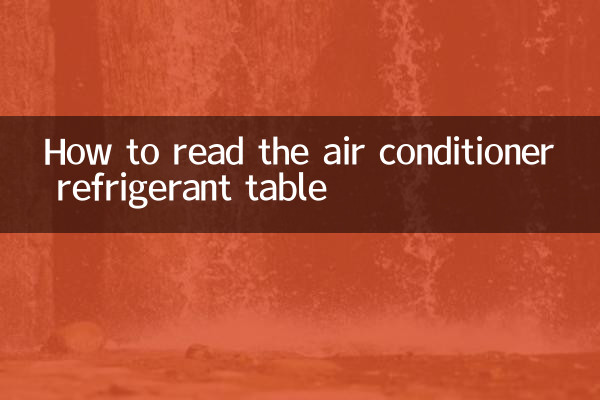How to read the air conditioner refrigerant table
The air conditioner refrigerant gauge (also known as the refrigerant pressure gauge) is an indispensable tool when repairing the air conditioner. It is used to detect the pressure status of the refrigeration system and determine whether the refrigerant is sufficient or whether there is leakage. Knowing how to correctly read the data on the refrigerant meter is crucial for air conditioning repair and maintenance. This article will introduce in detail how to view the air conditioner refrigerant table, and combine it with recent hot topics and hot content to help readers better understand the use of this tool.
1. Basic structure of air conditioning refrigerant table

The air conditioner refrigerant meter usually consists of a high-pressure meter (red), a low-pressure meter (blue) and connecting pipes. The following is a functional description of its core components:
| Part name | Function description |
|---|---|
| High voltage meter (red) | Displays the pressure value on the high-pressure side of the refrigeration system, usually used to detect compressor exhaust pressure. |
| Low pressure gauge (blue) | Displays the pressure value on the low-pressure side of the refrigeration system, usually used to detect the evaporator suction pressure. |
| Connecting pipe | Used to connect the air conditioning system and refrigerant meter to ensure accurate pressure transmission. |
2. How to read the data of air conditioner refrigerant table
Reading the data from the refrigerant table requires combining the working status of the air conditioner and the type of refrigerant. The following are common refrigerant pressure reference values:
| Refrigerant type | Low pressure side pressure (MPa) | High pressure side pressure (MPa) |
|---|---|---|
| R22 | 0.45-0.55 | 1.5-1.8 |
| R410A | 0.8-1.0 | 2.5-3.0 |
| R32 | 0.9-1.1 | 2.8-3.2 |
3. Recent hot topics: air conditioning maintenance and energy saving
In the past 10 days, air conditioning maintenance and energy conservation have become hot topics on the Internet. As high temperatures continue in summer and air conditioners are used more frequently, many users are concerned about how to reduce energy consumption through proper maintenance of air conditioners. The following is a summary of recent hot topics:
| topic | Hot content |
|---|---|
| Air conditioning energy consumption is too high | Experts recommend cleaning filters and checking refrigerant pressure regularly to improve air conditioning efficiency. |
| Refrigerant leakage problem | It has been reported in many places that the cooling effect of air conditioners has declined due to refrigerant leakage, and the need for maintenance has surged. |
| New environmentally friendly refrigerant | R32 refrigerant gradually replaces traditional R22 refrigerant due to its superior environmental performance. |
4. Common problems and solutions for air-conditioning refrigerant tables
When using the refrigerant table, you may encounter the following problems:
| Problem phenomenon | Possible reasons | Solution |
|---|---|---|
| Pressure gauge pointer does not move | The connecting pipe is not tightened or blocked | Check the connecting tube and retighten it. |
| The pressure value is abnormally high | The condenser has poor heat dissipation or too much refrigerant. | Clean the condenser or release some of the refrigerant. |
| Pressure value is abnormally low | Insufficient refrigerant or system leakage | Replenish refrigerant or check for leaks. |
5. Summary
Correctly reading the air conditioner refrigerant type table is a basic skill for maintaining air conditioners. Through the introduction of this article, readers can understand the structure of the refrigerant table, data reading methods, and solutions to common problems. Recent hot topics also remind us that regular maintenance of air conditioners can not only extend the life of the equipment, but also save energy and reduce environmental pollution. I hope this article can help everyone better use the air conditioner refrigerant table to ensure that the air conditioner operates efficiently.

check the details

check the details